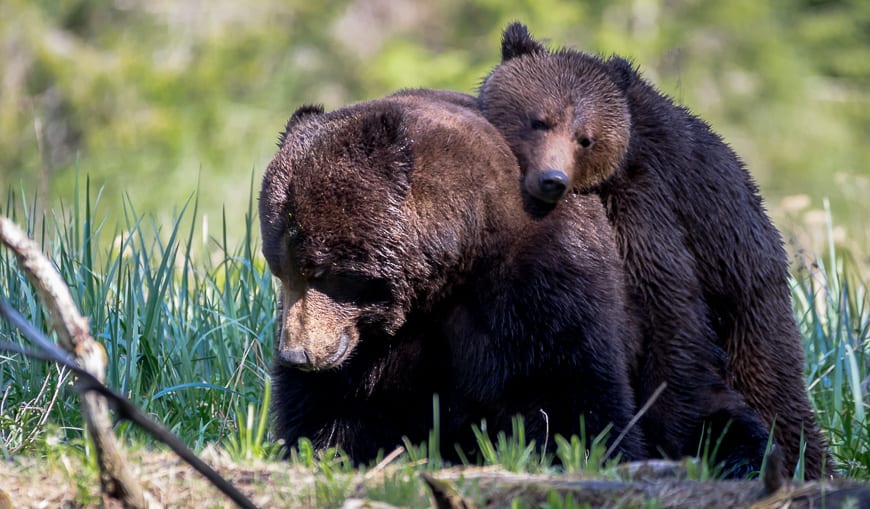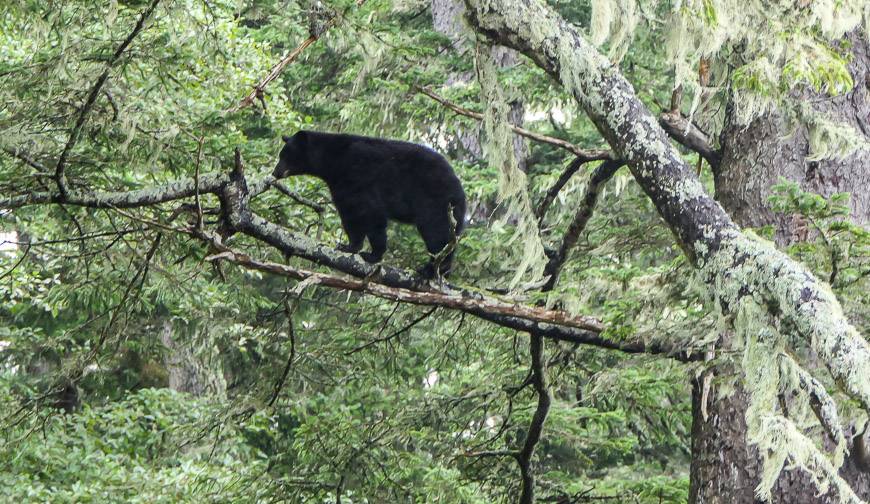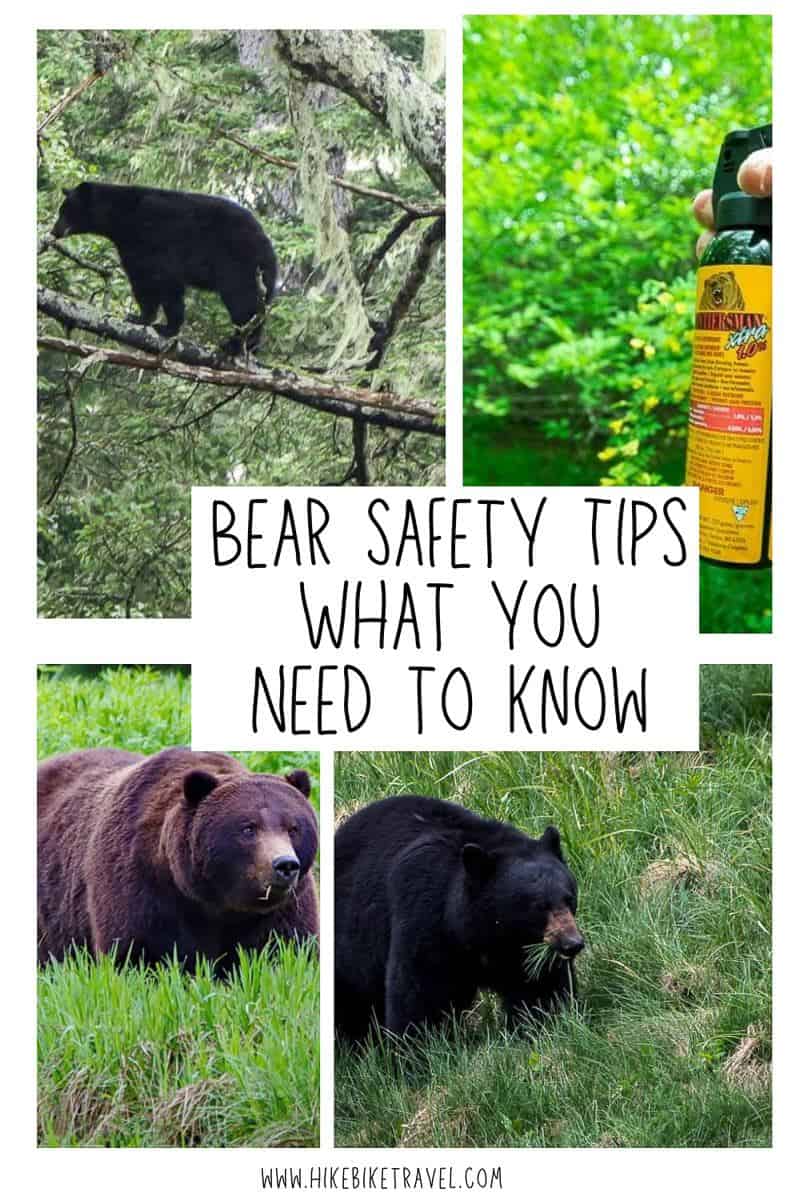Bear Safety Tips: What you Need to Know
To be comfortable and safe in bear country you need to have a good grasp of bear safety tips. There are a number of things you should know including how to distinguish between black and grizzly bears; what you should do if you encounter a bear and what preventative measures you should and can take.
The following bear safety tips could save your life if you follow them. If you’re in bear country always take a can of bear spray! Equally important – have the bear spray close at hand. It NEEDS to be quickly accessible – via either a holster at the front of your pack or an attachment at shoulder level. I have seen far too many hikers with the cannister swinging away on a carabiner at the back of their packs – or worse inside it.
Time yourself and see how long it takes to reach the bear spray under non-stressful situations. You’ll be a convert to having it close at hand.
This post includes some affiliate links. If you make a qualifying purchase through one of these links, I will receive a small percentage of the sale at no extra cost to you. Thank you very much for your support.

Would you like to save this?
Roadblocks to hiking
The two biggest roadblocks to hiking that I hear about most are lack of hiking companions and bears. I of course want to see everyone out hiking – enjoying nature, reducing stress and generally having a good time.
While finding the right hiking companion can be tricky, everyone should know these tips for bear safety – wherever that might be.
In western Canada and some parts of the western United States as well as parts of Alaska and northern Canada you can expect to find both black and grizzly bears. In eastern Canada and the eastern US you won’t find grizzlies. This blog doesn’t deal with polar bears as that’s a whole other kettle of fish.

Bear Safety Tips
Learn to tell the difference between a black bear and a grizzly bear
Size and colour can vary greatly in both types of bears so those features in themselves will not help you. However, grizzly bears are usually medium to dark brown in colour and the average size is 160 kg (350 lb) to 225 kg (500 lb) though a male grizzly can weigh up to 360 kg (800 lb). Black bears average 50-140 kg (110 – 300 pounds).
From afar the biggest distinguishing characteristic is the distinct shoulder hump found in the grizzly bear. It is entirely absent in the black bear. Also, the claws of a grizzly are much bigger and can be seen in most grizzly bear tracks.
If you see an enormous bear, it’s a grizzly.



Safety tips on what to do when you see a bear
There are a couple of scenarios. You may see the bear but it doesn’t see you, the bear sees you but you don’t see it (in which case ignorance may be bliss) or you see each other at about the same time. The reality is that most bears take off the minute they see you.
Safety tips if a bear sees you but doesn’t run away
- Keep an eye on the bear but don’t make direct eye contact.
- Provide the bear with an escape route.
- Try to figure out if there are any cubs. A bear can have anywhere from one to three cubs. Getting between a female bear and her cubs is never a good thing and leaving the area is of paramount importance – but never run.
- Speak in a calm voice. Up at Great Bear Lodge in British Columbia they’d keep repeating in a very soothing voice – Hey bear. Modulating the tone of your voice is also helpful.
- Remain in a tight group with four people being the magic number to avoid a bear attack. There are some hikes in Banff National Park where you are required to hike as a group of four, even if it means waiting to collect random people to form the group, as the park’s research has indicated that there has never been an attack on a group with a minimum of four people. Use some common sense and make noise in areas frequented by bears.
- Make yourself look bigger.

More bear safety tips
If the bear heads in your direction it may just be curious and trying to figure out what you’re all about. It doesn’t mean they are going to attack but still – follow these bear safety tips.
- Yell and speak loudly and authoritatively.
- If the bear charges stand your ground as it’s usually a bluff. One book I read described a bear that charged – and bluffed four times.
- Never run away from a bear. They can clock 40 km/hour in short order and they are incredibly strong swimmers. If your dog is off leash, get them on a leash immediately. You don’t need an agitated bear.
- Bear spray is incredibly effective – BUT ONLY AT CLOSE RANGE.
Up at Great Bear Lodge (where they see bears multiple times a day) they recommended the following to me.
“Fire the spray when the bear is about 20 feet away, to create a cloud that the bear will run into. And we only suggest spraying for a second or two. You don’t want to empty the whole can in your first shot, as you may need to use it a second time on the bear.”
I have also been told to fire for six seconds at six feet. Personally I would rather shoot a bit of spray and hope like hell the bear turns away.
Bear spray shelf life: Bear spray lasts between two to three years. Eventually it’s the repellent that goes. Keep track of how old yours is.

In the VERY rare case that a bear continues towards you or attacks remember
- One of the safety tips related to black bears is DO NOT CLIMB A TREE but back away slowly and DO NOT PLAY DEAD!
- If it’s a grizzly bear back away slowly and TRY to CLIMB a tree. But you need to get high in the tree (more than 4 m up) or the bear can pull you down. If it attacks protect your head and stomach area and PLAY DEAD!

For both types of bears there are times where you have to fight for your life. In very rare circumstances both grizzly and black bears can become predatory and fighting is the only way to go. That’s a big reason to carry bear spray.
According to a post in Alaska Life, two to five people are killed by bears in North America every year. Although that statistic captures our imagination in the worst way possible, there are more common ways of dying outdoors (hypothermia, falls, snake bites…) that don’t get nearly the press.
We’re all probably hardwired to fear bears, but again common sense, making noise, avoiding areas well-traveled by bears and carrying bear spray will go a long way to avoiding any sort of incident.

How to avoid bears altogether
Short of staying home there is always the possibility that you’ll see a bear or inadvertently cross paths. But for me, despite all the hiking and biking I’ve done in bear country, it is a rarity that I see a bear.
Make a lot of noise
Your chances of seeing bears will decrease if you make a lot of noise – and by noise I mean using your voice – where you vary the tone and volume, one of the easiest of the bear safety tips to employ. Ditch the bear bells people. They won’t help you, their noise will drive you nuts and they may even give you a false sense of confidence.
Avoid avalanche slopes
Avoid avalanche slopes as bears like to hang out there. Hike between late morning and early afternoon when bears aren’t as active. If you see a steaming pile of bear scat or some young cubs then make heaps of noise and leave the area as fast as you can.
Rogue bears are rare
There are a few rogue bears that give all bears a bad name. Most bears do not have any desire to engage with humans unless they or their cubs are threatened. If you stay bear aware on a hike, the odds are overwhelmingly in your favour that you will be just fine. Now go find yourself some great hiking companions, perhaps through a local club or university outdoor program, and plan a hike you’ve always wanted to do.
A reason to never go into bear country
If you looking for a reason never to hike in bear country then look no further than the book, The Bear’s Embrace by Patricia Van Tighem It’s a thoughtful and very well-written book about her attack by a grizzly bear.


Bear safety tips – carry bear deterrent
The best bear deterrent is a can of bear spray that is at most three years old. You’ll find bear spray in camping and outdoor type stores. Know how to use it and keep it accessible. You must be 18 years of age to purchase it. Keep your bear spray out of reach of children.
One of the important safety tips if you’re camping in bear country is to keep your tent scent-free and your food put away, either by hanging it off a pole or tree or by using a bear cannister like this one.
Be careful with bear spray
In the last year I know of four incidents with bear spray between my husband and myself and a couple of friends, including a friend who knocked the safety off and sprayed herself in the eye. Next up was a shower and a trip to emergency!
Be sure the safety latch is on. It should be held by a short cable tie so you never lose it. If the bear safety latch is not on, you need to do something about it quickly. If it ever went off in a car, tent or other confined place, you could have an emergency on your hands.
Further reading on adventures in the backcountry
- Nootka Trail Hike: A Complete Guide & Trip Report
- Brazeau Loop Trail Hike in Jasper National Park
- Camping for Beginners – What You Need to Know
- Hiking in Alberta: 16 of the Must-Do Day Hikes
- 37 Long Distance Hiking and Backpacking Trails in Canada
Click on the photo below to bookmark to your Pinterest board.





Hi Leigh,
We’re due to return to Canada (from Australia) this September and want to do some hiking up at Tweedsmuir Provincial Park in BC. I’ve heard that it’s bear country so am I bit wary but I think you’ve also hiked there without issues?
Do you know if you can buy bear spray at Canadian Tire? Last time we came to Canada, I think the bear spray we were given was a little old so I want to make sure we get some fresh stuff this time.
Thanks for a really helpful post!
@Kati You definitely want bear spray for Tweedsmuir. Canadian Tire does carry it as well as almost any outdoor kind of store. I would recommend one can each – and having it accessible in a holster is a good idea. Twice I have had mine ready and then the bears took off.
Bears do not only eat flowers and poop rainbows. They do eat meat and hunt for it. With that being said, sometimes it is human on the menu. There are many different reasons why bears attack and the ones that do are not rogue. Getting people to believe that bears are only dangerous if they have Cubs is incredibly wrong. They are strong, fast and opportunistic creatures.
@Chris I agree that they do eat meat but it is a rogue bear – of which there are very few – that hunt down humans. And I appreciate that they can be black or grizzly bears. BUT most bears get the hell out of the way when they see humans.